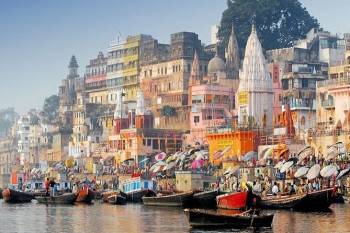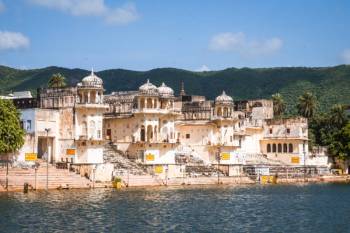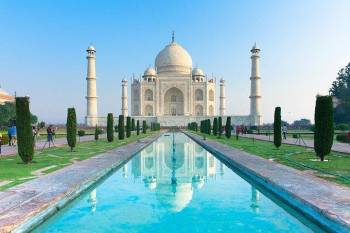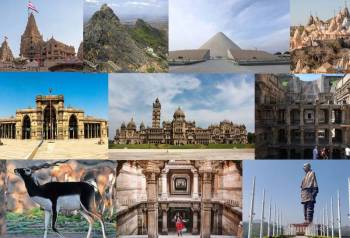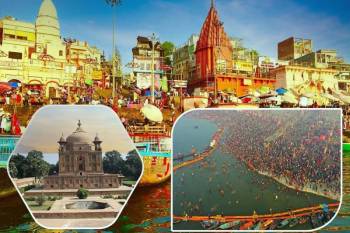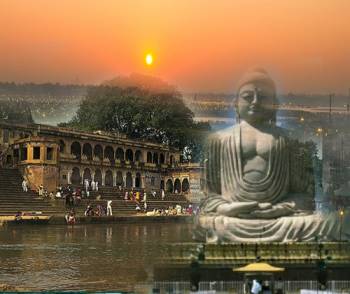12 Jyotirlinga Temples Tour 20 Nights - 21 Days
Duration : 20 Nights / 21 Days
Destination Covered : New Delhi, Varanasi, Haridwar, Hyderabad, Rameshwaram, Porbandar, Ujjain, Aurangabad, Mumbai, Nashik, Pune, Omkareshwara, Guptakashi, Nandyal, Durga Temple, Bhimashankar Wildlife Sanctuary, Mecca Masjid, Omkareshwar Temple, Vishwanath Temple, Har Ki Pauri, Khandoba Temple, Temples, Birla Mandir, Salar Jung Museum, Rameshwaram Temple, Charminar, Godavari River
Tour Activities : Museums, Sightseeing
Tour Themes : Religious & Pilgrimage, Culture & Heritage, Monuments & Historical Places
Price on Request
New Delhi, Varanasi and Haridwar Tour Overview
A Jyotirlinga is a symbol of Shiva that depicts all the energies in the world or beyond. The term is a compound of two Sanskrit words ‘Jyotis’ meaning ‘radiance’ and ‘Linga’ meaning ‘sign, symbol, or mark.’
According to Shiva Mahapurana, once Brahma and Vishnu debated over the supremacy of creation. To settle the argument, Shiva took the form of a huge infinite pillar of light, piercing the three worlds and challenged them to find the source. To find the end of this pillar, both Brahma and Vishnu parted their ways. Vishnu went in a downward direction while Brahma went in an upward direction. After getting tired, both the gods gave up. While Vishnu acknowledged his defeat, Brahma lied, and it made Shiva angry, and he cursed Brahma that he would not be worshipped even though he is the creator of the universe.
So, a Jyotirlinga represents the infinite nature of Shiva and at all Jyotirlinga temples in India, he appeared as a fiery column of light.
In the Taittiriya Upanishad, the twelve Principles of Brahma, Maya, the jiva, the mind, intellect, subconscious mind, ego and the Panchamahabhutas have been referred to as the twelve Jyotirlingas.
New Delhi, Varanasi and Haridwar Tour Itinerary
Later, you will return to the hotel. Overnight stay at the hotel in Bhimashankar.
As you reach Sainagar, start a visit to Samadhi Mandir where the sacred body of Sai Baba is resting in peace. The Samadhi is built up of white marble and railing is decorated with ornaments. Then, move to Khandoba Temple. It is the place where Sai Baba was welcomed by Poojari Mhalsapati who said "Aao Sai" when he stepped in Shirdi. This temple consists of two small shrines – one shrine contains the idol of Baba and his Charan Padukas and another shrine houses Lord Khandoba's horse idol. After that, visit Shri Sai Baba Sansthan Complex. Devotees must visit this holy place to experience pure tranquility, bliss, and God from close quarters. The huge shrine includes many temples such as Chavadi, Gurusthan, Samadhi Mandir, DwarkaMai, Khandoba Temple, Lendi Garden, and much more.
Now, you will proceed to Shani Shingnapur which is located 65 km from Shirdi. This place highlights the kindness and power of God Shani. It is dedicated to Lord Shaneshwar or Lord Shani Dev. The unique aspect of this place is that there is no temple structure for the Swayambhu Idol of the Shani Dev and this black stone idol stands only on a simple platform. In addition, the houses in village Shingnapur have no doors, locks, or frames for safety because they believed that Shani Dev always protects their houses from thieves.
This place is believed to be the home of Lord Shani, worshipped as the personification of Lord Saturn. Visit the temple and pay your respect to Lord Shani. Then, you will head towards Aurangabad. On arrival, check-in at the hotel. The rest of the time is at your leisure.
Overnight stay at the hotel in Aurangabad.
The Grishneshwar Jyotirlinga is one of the 12 Jyotirlingas. This is a UNESCO World Heritage which is located in Ellora. This is an architectural marvel that will leave you spellbound. Seeks blessing here and have an enchanting experience.
Later, head towards Nashik. On arrival, have an assisted transfer to the pre-booked hotel. The rest of the day is at your leisure. You can rest or take a stroll near the resort.
Overnight stay at the hotel in Nashik.
The Trimbakeshwar Temple is located at the foothills of Brahmagiri Mountain which is also the origin point of the holy river Godavari. As per Shiv Puran, Gautami Rishi and Godavari River pleaded Lord Shiva to reside here. The Jyotirlinga in the temple has three faces embodying Tridev, Lord Brahma, Vishnu, and Shiva. Praying here bestows longevity and immortality. There are four entry gates in each direction East, West, South, and North. Every direction has spiritual conceptions like East stands for the beginning, West stands for maturity, South stands for completion or fulfillment and North denotes for the revelation. The temple was built in the 18th century in Nagara-style architecture. The temple is popular for its intricate carvings of deities, humans, animals, and flowers. Take part in the Pooja and seek blessings.
Later return back to the hotel and savor breakfast. After breakfast, you will leave for Mumbai. Enjoy the scenic view en-route. On arrival, have an assisted check-in at the hotel in Mumbai. The rest of the day is at your leisure. You can visit the nearby beach and spend the evening while enjoying the sunset. You can visit the local market and relish in the vibrant aura of Mumbai.
Overnight stay at the hotel in Mumbai.
Later, head towards Porbandar. Overnight stay at the hotel in Porbandar.
Somnath Jyotirlinga Temple is located near the ancient Triveni Sangam of three rivers – Hiran, Kapila, and Saraswati. Somnath Temple is dedicated to Someshwar which is another name of Lord Shiva who possesses a moon on his head. The lingam here was built by Chandra (Moon) to worship Lord Shiva. The sculptures and carvings in this temple speak volumes about great artisan work of that era. This marvelous edifice boasts of the Chalukya style of architecture. Adore the majestic beauty of this pilgrimage site and revel in the tranquil aura of this pilgrimage site.
Later, return to Porbandar. Overnight stay at the hotel in Porbandar.
You can visit the temples of the city and delve into the tranquil aura of this pilgrimage site. The city is located on the bank of River Kshipra. You can also spend the evening on the bank of the river.
Overnight stay at the hotel in Ujjain.
After that, come back and have a sumptuous breakfast. Now, drive towards Omkareshwar. This land is shaped like "Om" which is a holy symbol in Hinduism.
After reaching, complete all the formalities and get over tiredness. In the evening, you will pay homage at the Omkareshwar Temple which is situated on an island Shivapuri, along the Narmada River. This temple features pristine beauty, lofty hills and is also an epitome of Indian culture & heritage. You will attend the evening Aarti at the temple.
Later, come back to the hotel for an overnight stay.
In the afternoon, savor your lunch and visit the Mallikarjuna Jyotirlinga Temple which was built by King Harihara Raya of the Vijayanagar Empire. This temple was constructed in the Dravidian architectural style and has sprawling courtyards and lofty towers. Here, you will see the idols of Sahasralinga, Nandi, Nataraja, and sage Bringi standing on three legs. The pillars and walls of this temple are embellished by delightful sculptures and carvings that attract many devotees to visit this place.
In the evening, you will attend the aarti at the shrine. After that, return to the hotel for an overnight stay.
Firstly, visit the Salar Jung Museum which is one of the three national museums in the country. It has a huge collection of one million paintings, carvings, artifacts, sculptures, manuscripts, and some art collections that date back to the first century. This museum also contains some rare and valuable pieces such as Aurangzeb's sword, painting of Raja Ram Mohan Roy, a full wardrobe of Tipu Sultan, daggers that belonged to Jahangir and Shah Jahan and a musical clock that dates back to the 19th-century.
Next, you will visit Charminar which is the most prominent landmark in the city. It was erected by Quli Qutub Shah and stands out to remind the glorious past. The massive structure includes four minarets that epitomize the first four Prophets (Khalifas) of Islam. This place is famous for the market that sprawls around it which is called "Chudi" or "Laal" Bazaar.
At last, visit the Mecca Masjid also known as Makkah Masjid. It was built by Muhammad Quli Qutub Shah and is made up of bricks and soil which were exported from Mecca. This mosque can accommodate as many as 10,000 devotees at one time. This place attracts tourists because of its peaceful atmosphere and its spiritual environment.
After a soothing day, head back to the hotel in Hyderabad for a relaxing overnight stay.
After reaching Madurai, you will go to Meenakshi Amman Temple which is a cultural paradise on earth. This temple is dedicated to the Meenakshi, a form of Goddess Parvati and her spouse Sundareshwar, a form of Lord Shiva. The architecture of Meenakshi Amman Temple is of the Dravidian style and referred to as the "Mathura of South". The eternal glory of this temple will take your breath away.
After that, you will proceed to Rameshwaram by road. Rameshwaram is situated on Pamban Island and is home to one of 12 Jyotirlingas and one of the Char Dhams in India. It is believed that Lord Rama built a bridge here to reach Sri Lanka to save his wife Sita from a demon named Ravana.
Upon reaching, check-in the hotel. Savor your dinner and enjoy a comfortable sleep.
Later, come back to the hotel to have your breakfast. Then, check-out from the hotel and go back to Madurai by road. Thereafter, you will be dropped at Madurai airport and here, you will board the flight to Delhi at 2 pm. Upon arrival, a tour representative will transfer you to the hotel. Complete the check-in formalities and the rest of the day is at your leisure. You can take a stroll on the streets of the national capital and revel in the vibrant aura of the capital city, Delhi.
Overnight stay at the hotel in Delhi.
Later in the evening, attend the Ganga Aarti at Har-ki-Pauri and delve into the spiritual aura of this religious place.
Overnight stay at the hotel in Haridwar.
Overnight stay at the hotel in Guptkashi.
After taking the blessings of Lord Shiva, you will come back to Phata by helicopter. Then, you will go back to your pre-booked hotel.
Overnight stay at the hotel in Guptkashi.
After reaching there, you will have an assisted transfer to Haridwar Railway Station to catch the train to Varanasi. You will enjoy the overnight journey aboard.
Varanasi is the most prominent pilgrimage site for Hindus and is famous as the 'Spiritual Capital of India'. Thousands of tourists come here to attain salvation. This city is also known as Kashi. This is an auspicious place which is believed to grant moksha and liberate one from the cycle of life and birth. As per the mythology, this is the city of Lord Shiva.
In the evening, you will proceed to attend the Ganga Aarti at Dashashwamedh Ghat. This mesmerizing ceremony is the combination of immense grandeur and opulence. Priests line up to perform the aarti while lighting up thousands of lamps in front of the River Ganges.
After that, come back and enjoy a sound sleep at the hotel. Overnight stay at the hotel in Varanasi.
Firstly, visit Durga Temple which is located in the Durga Kund, and is dedicated to the Goddess Durga. It was constructed by a Bengali Maharani in the 18th-century. The statue of Goddess Durga appeared on its own in this temple. It is believed that Durga Maa always protects Varanasi from problems. Then, move to the Tulsi Manas Temple which was constructed in 1964 and is dedicated to Lord Rama. This temple is installed at the same place where Goswami Tulsi Das had written an ancient Hindu Epic Ramcharitamanas. It exhibits various inscriptions on the walls that come from the Ramcharitmanas.
After that, go to Birla Mandir. Flaunting the tallest temple tower in the world, the shrine is also called as the new Vishwanath Temple. Subsequently, you will explore Vishalakshi Temple which is situated at Mir Ghat and is one of the 51 Shakti Peetha. This temple is dedicated to Goddess Vishalakshi Devi, a divine form of Goddess Sati. Thereafter, pay a visit to the Annapurneshwari Temple which is also called as Annapurna Temple. This shrine is dedicated to the Annapoorna Mata, the Goddess of Food, and one of the forms of Goddess Parvati.
Now, seek the blessings at Shri Kashi Vishwanath Jyotirlinga Temple, also called the Golden Temple which is dedicated to Lord Shiva. The almighty is known as Vishweshwara here that means the 'Ruler of Universe'. It was constructed by the Maratha Monarch, Maharani Ahilyabai Holkar in 1780 and considered as a much-revered pilgrimage site for the Hindus. It is believed that Lord Shiva resided here and always offers happiness and liberation to all.
Afterward, you will leave for Sarnath which is 10 km away from Varanasi. It is one of the 4 holiest places for the Buddhists. It is the place where Lord Buddha preached his first sermon and is well-known for the mystical setting, museums, beautiful temples, numerous Buddhist stupas. The magnificent monuments are Chaukhandi, Dharmarajika, and Dhamek Stupas.
By late evening, you will be transferred to Varanasi railway station to catch the train to Deogarh. Overnight Journey in Train.
After that, go to Basuki Nath Temple. It is believed that this temple is the court of Baba Bhole Nath. The shrines of Lord Shiva and Goddess Parvati are situated in front of each other in the Basuki Nath Temple. The gates of these temples open in the evening and according to Hindu beliefs, Lord Shiva and Goddess Parvati meet each other at this time. If you have time, you can also attend the evening aarti here.
After a pleasurable day, return to the hotel. Overnight stay at the hotel in Deogarh.
Later, you will have an assisted transfer to the Patna airport from where you can board a flight for your onward destination.
More Details about New Delhi, Varanasi and Haridwar Tour
Inclusions
- CP (Room + Breakfast)
Payments Terms
- * 20% Advance Percentage of total booking amount
Cancellation & Refund Policy
- * Upon cancellation, refund will be made after deducting the Retention Amount.
Packages by Theme
Similar Tour Packages for New Delhi, Varanasi, Haridwar, Hyderabad, Rameshwaram, Porbandar, Ujjain, Aurangabad, Mumbai, Nashik, Pune, Omkareshwara, Guptakashi, Nandyal
Explore Tour Packages by Destination


